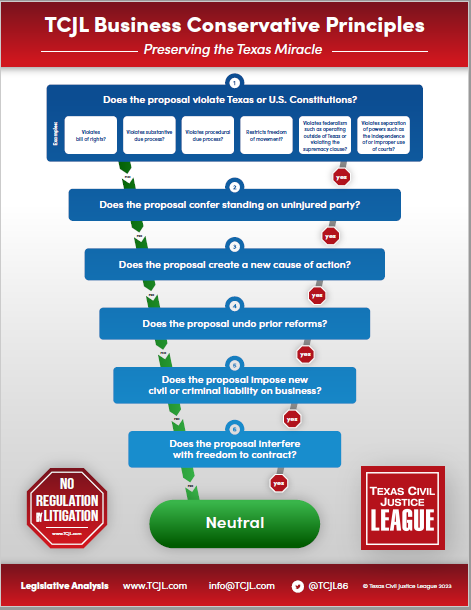
The Texas State Capitol from the top of the Dewitt C. Greer building. Photo by Stan A. Williams
The House Judiciary & Civil Jurisprudence Committee heard SB 779/HB 3964, the so-called “public nuisance” bill, on April 23. As you might expect, this bill cuts into the way governmental entities and some plaintiff’s lawyers attempt to leverage corporate defendants for bigger settlements in tort cases. Never mind that “public nuisance” doesn’t exist as a cause of action in Texas, or that the Texas Supreme Court has established extremely high standards for proving up “intentional nuisance” as a type of injury, something quite different from a cognizable legal theory of liability. In any event, SB 779/HB 3964 merely seek to interdict an increasingly common form of lawsuit abuse: pleading public nuisance in every environmental or product liability case in an effort to duplicate and ramify potential damages.
For what it’s worth, then, let’s look specifically at what the bill does and doesn’t do.
- First, we need to be clear about what “nuisance” is and what it is not. As Justice Boyd stated in the definitive SCOTX opinion on the matter, Crosstex N. Tex. Pipeline, L.P. v. Gardiner, W.3d 580 (Tex. 2016), “‘nuisance’ refers not to a defendant’s conduct or to a legal claim or cause of action but to a type of legal injury involving interference with the use and enjoyment of property.”
- Both SCOTUS and SCOTX have cast doubt on whether a nuisance “claim,” public or private, even exists. As Justice Blackmun wrote, “one searches in vain … for anything resembling a principle in the common law of nuisance.” Lucas v. S.C. Coastal Council, 505 U.S. 1003, 1055 (1992) (Blackmun, J., dissenting). Quoting a seminal environmental law treatise, Justice Blackmun wrote further that nuisance “is an area of law that ‘straddles the legal universe, virtually defies synthesis, and generates case law to suit every taste.” At 1055, n.19. In 2004 SCOTX observed that, according to Justice Boyd, “the Texas test for distinguishing temporary nuisances from pernament ones ‘has no standard of reference,’ and thus leads to irreconcilable precedent in our courts. Schneider Nat’l Carriers, Inc. v. Bates, 147 S.W.3d 264, 274-75 (Tex. 2004), holding modified on other grounds, Gilbert Wheeler, Inc. v. Enbridge Pipelines (E.Tex.), L.P., 449 S.W.3d 474 (Tex. 2014). We observed that nuisance law was such a morass that although half of the precedent had to be wrongly decided, we cold say which half that was. Id. At 274.”
- Crosstex held that in order to establish an intentional nuisance, “the evidence must establish that the defendant intentionally caused the interference that constitutes the nuisance, not just that the defendant intentionally engaged in the conduct that caused the interference.” 505 S.W.3d at 605. Nothing in SB 779/HB 3964 changes this rule in any way.
- SB 779/HB 3964 simply puts in the statute what the Crosstex court said: even there is a claim for “public nuisance”—which SCOTX has not recognized and shows no signs of recognizing—there is no certainly no public nuisance claim based on the defendant’s conduct, that is, regulatory compliance matters or product liability claims.
- In other words, SB 779/HB 3964 does not abrogate a common law cause of action because the cause of action is not part of the common law in Texas to begin with. The bill simply makes it clear that plaintiffs cannot go on pleading public nuisance as an “add-on” theory in every environmental or product liability case against a business or industry.
- As Dean Prosser said many years ago (and it is still true today), nuisance is the law’s “garbage can.” William L. Prosser, Nuisance Without Fault, 20 Tex. L. Rev. 399, 410 (1942). SB 779/HB 3964 simply says what SCOTX has said already: we are not going to convert a garbage can into a garbage dumpster by allowing plaintiffs to reframe cases involving alleged regulatory violations or product defects as “public nuisance” claims in hopes of getting something to a jury that will substantially increase the settlement value of an otherwise standard tort case.
We will undoubtedly hear all sorts of claims from opponents of the bill about how this bill will somehow “take away” a remedy or a right to sue. That is utterly bogus under any interpretation of current Texas law. If we’re going to have a policy debate over whether a public nuisance claim might be cognizable under certain, outlying circumstances, let’s have it. But this bill has nothing to do with that at all. It has only to do with an abusive pleading practice that has far other aims than advancing public policy.











